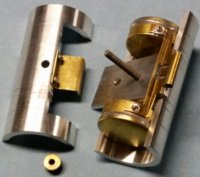Update:
Back in the second week of April of this year, I found that the brass float in my 1974 Kawasaki F11 had once again taken on gas, despite a soldering repair seeming to be successful last spring. As you know, these floats are delicate, so the soldering repair needs to be very carefully accomplished.
However, applying some sort of sealer would perhaps be easier and less likely to damage the float.
I found two posts at other websites of guys who said that Seal-all worked for them, but their tests lacked specificity and long term follow-up.
So I called Tech at Eclectic Products, the maker, and asked about their research base regarding their claim:
"What are some suggested uses for Seal-All?
Use for distributor caps, interior panels, radiators, gaskets, transmission, carburetor floats, body and trunk leaks, battery cables and terminals, generators, tools and much more."
The tech operator was straight with me; "Sir, our research dept. is very busy, and they haven't actually substantiated that Seal-all will work long term on carb floats. However, if you want to test it yourself, I would be pleased if you get back to me with what you find."
So, I brushed one layer of Seal-all onto my float after cleaning and scuffing with ScotchBrite pad,

and did the same to a section of brass tubing,

and then cut the coated piece off, and placed in gasoline.
Now, 6 months later, the Seal-all seems to have maintained its integrity and has not become brittle. And my F11 shows no signs of float issues.

It is going back into the gas bath.
I hope this is helpful to someone.
Back in the second week of April of this year, I found that the brass float in my 1974 Kawasaki F11 had once again taken on gas, despite a soldering repair seeming to be successful last spring. As you know, these floats are delicate, so the soldering repair needs to be very carefully accomplished.
However, applying some sort of sealer would perhaps be easier and less likely to damage the float.
I found two posts at other websites of guys who said that Seal-all worked for them, but their tests lacked specificity and long term follow-up.
So I called Tech at Eclectic Products, the maker, and asked about their research base regarding their claim:
"What are some suggested uses for Seal-All?
Use for distributor caps, interior panels, radiators, gaskets, transmission, carburetor floats, body and trunk leaks, battery cables and terminals, generators, tools and much more."
The tech operator was straight with me; "Sir, our research dept. is very busy, and they haven't actually substantiated that Seal-all will work long term on carb floats. However, if you want to test it yourself, I would be pleased if you get back to me with what you find."
So, I brushed one layer of Seal-all onto my float after cleaning and scuffing with ScotchBrite pad,
and did the same to a section of brass tubing,
and then cut the coated piece off, and placed in gasoline.
Now, 6 months later, the Seal-all seems to have maintained its integrity and has not become brittle. And my F11 shows no signs of float issues.
It is going back into the gas bath.
I hope this is helpful to someone.


